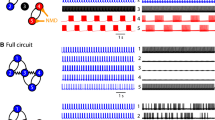Abstract
RHYTHMIC motor behaviours are generated within the central nervous system by neuronal circuits called central pattern generators (CPG)1. Although a CPG can produce several forms of the same behaviour2–5 and several circuits may interact to generate different behaviours6, it is generally assumed that a given CPG consists of a predefined assemblage of neurons that is functionally distinguishable from other circuits. However, recent studies on the stomatogastric nervous system of Crustacea have suggested that CPGs may not be immutable functional entities7–10. We now report that under an identified neuromodulatory stimulus, the CPG that produces swallowing-like behaviour of the foregut in lobsters is constructed de novo from neurons belonging to other CPGs. Consequently neurons operating independently as members of different circuits may be reconfigured into a new pattern-generating circuit that operates differently from the original circuits. This not only challenges the concept of the CPG being a discrete functional entity, but also demonstrates that a modulatory input can specify an appropriate CPG from a pool of individual neurons of diverse origins.
Similar content being viewed by others
References
Delcomyn, F. Science 210, 492–498 (1980).
Nagy, F. & Moulins, M. in The Crustacean Stomatogastric System (eds Selverston, A. I. & Moulins, M.) 205–262 (Springer, Berlin, 1987).
Marder, E. Nature 335, 296–297 (1988).
Harris-Warrick, R. M. in Neuronal Control of Rhythmic Movements in Vertebrates (eds Cohen, A. V., Rossignol, S. & Grillner, S.) 285–331 (Wiley, New York, 1988).
Stein, P. S. G., Mortin, L. I. & Robertson, G. A. in Neurobiology of Vertebrate Locomotion (eds Grillner, S. et al.) 201–216, (Macmillan, London, 1988).
Grillner, S. Science 228, 143–149 (1985).
Meyrand, P., Weimann, J. M. & Marder, E. Soc. Neurosci. Abstr. 14, (1988).
Hooper, S. L. & Moulins, M. Science 244, 1587–1589 (1989).
Dickinson, P. S., Mecsas, C. & Marder, E. Nature 344, 155–158 (1990).
Weimann, J. M., Meyrand, P. & Marder, E. J. Neurophysiol. 65, 111–122 (1991).
Selverston, A. I. & Moulins, M. (eds) The Crustacean Stomatogastric System (Springer, Berlin, 1987).
Cazalets, J. R., Nagy, F. & Moulins, M. J. Neurosci. 10, 448–457 (1990).
Cazalets, J. R., Nagy, F. & Moulins, M. J. Neurosci. 10, 458–468 (1990).
Robertson, R. M. & Laverack, M. S. Proc. ft Soc. B206, 235–263 (1979).
Author information
Authors and Affiliations
Rights and permissions
About this article
Cite this article
Meyrand, P., Simmers, J. & Moulins, M. Construction of a pattern-generating circuit with neurons of different networks. Nature 351, 60–63 (1991). https://doi.org/10.1038/351060a0
Received:
Accepted:
Issue Date:
DOI: https://doi.org/10.1038/351060a0
- Springer Nature Limited
This article is cited by
-
Cellular switches orchestrate rhythmic circuits
Biological Cybernetics (2019)
-
The dark matter of the brain
Brain Structure and Function (2019)
-
Central Pattern Generators
Neuroscience and Behavioral Physiology (2015)
-
Circuits controlling vertebrate locomotion: moving in a new direction
Nature Reviews Neuroscience (2009)
-
Modulation of stomatogastric rhythms
Journal of Comparative Physiology A (2009)





